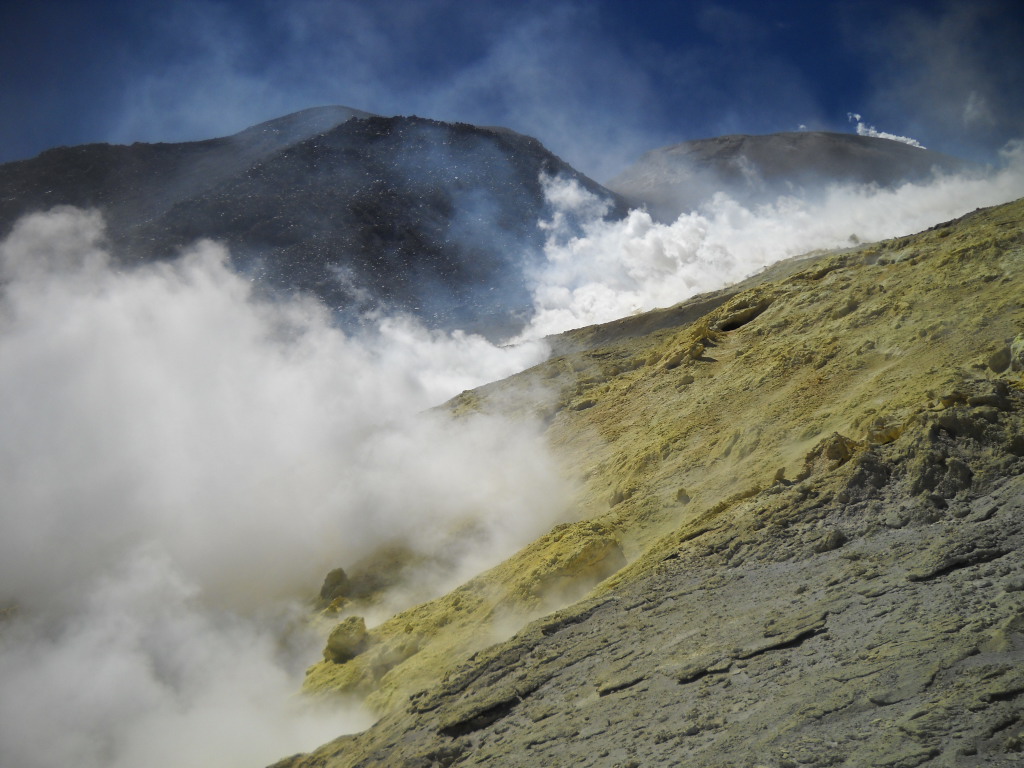Did You Know Volcanoes Can Erupt Molten Sulfur?
Posted on Categories Discover Magazine

If you took our whole planet and ground it up into a powder, then analysed that powder for its elemental composition, what would you find? A third of the powder would be iron, another third would be oxygen. Of the remaining ~35%, 30% of it is magnesium and silicon. Most people would guess that maybe elements like carbon or hydrogen would be next on the list … but they’d be wrong. The element that ends up at #5 on the list is sulfur.
Now, this exercise of thinking of a “bulk Earth” shows how biased we are by the surface of our planet when we ponder its composition. Most of the mass of our planet is in the planet’s metallic core (iron, mostly). Silicon and magnesium are found in the rocks of the Earth’s mantle, the primary rocky component of Earth. Oxygen — well, it’s everywhere, bonding with elements to form a large portion of the minerals from the core to the crust.
So, why sulfur next? Sulfur loves to bond with metals, so our core has a lot of sulfur it in. Sulfur also exists in the rocky parts of our planet and when those rocks melt, sulfur can exist as a gas that is released along with water vapor and carbon dioxide.
Sulfur from Volcanoes
Volcanoes will emit these gases passively and actively as magma cools and released these gases. We measure the amounts of sulfur dioxide emitted by many volcanoes and even when they aren’t erupting, they are released hundreds to thousands of tons of sulfur dioxide per day. If you’re ever been to a volcanic area like around Hawaii’s Kīlauea or Yellowstone caldera, you’ve likely got a whiff of that rotten egg smell that comes from hydrogen sulfide. The yellow crust around steam vents (known as fumaroles) is evidence of sulfur crystallising out of gases and liquids at these volcanoes.
There are some volcanoes around the globe that also create flows made of molten sulfur! So, instead of flows of molten rock we get rivers of liquid sulfur that can reach hundreds of feet. The occurrence of these types of sulfur flows is rare, so although we see evidence of past sulfur flows at places like Mauna Loa in Hawaii, numerous volcanoes in Japan and even some submarine volcanoes, our understanding of how and why they form is scant.
One of the places where sulfur lava flows seem to be more common is the Andes of northern Chile. In this part of the world, many volcanoes have active fumaroles (gas vents) that release sulfur and their summits can be covered with sulfur deposits that came from all these hot, acidic volcanic gases rising through the volcano.
Watching Sulfur Flows
Landsat 9 image taken in 2023 showing Lastarria and the sulfur field on its northern slope. Credit: USGS/NASA, Erik Klemetti.
A study that was just released in Frontier in Earth Science by Manuel Inostroza and colleagues describes some of the most recent sulfur flows on Earth. They were formed in 2019-2020 at Lastarria, a volcano that straddles in the Chile-Argentina border in the high Andes. They were able to measure, sample and even video the small sulfur flows that the volcano was producing. They’ve developed some theories on how sulfur flows may form at volcanoes from these observations.
The sulfur flows at Lastarria that Inostroza and others documented weren’t big. They reached up to ~180 feet (55 meters) down the slopes of the volcano, and some were much smaller than even that. However, they looked like miniature versions of lava flows like one finds in Hawaii, with lobes and levees (see below).
Unlike lava, however, the sulfur flows were much cooler. The eruption temperature was between 120-150C. Now, compare that to the ~1200C that is seen at Kīlauea. However, the melting point of pure sulfur is only 119C … which offers one of the first clues to how these strange flows might form.
These sulfur flows are full of many other elements as well, just in very small amounts. Not surprisingly, many of the elements that like to bond with sulfur were there: copper, lead, bismuth, tin as well as more exotic elements like lithium, uranium and niobium (the latter three at less than one part per million). The sulfur flows at Lastarria are also full of arsenic, something not found in such high abundances at other sulfur flows.
How do sulfur flows form?
Sulfur flow captured at Lastarria in the Andes. Credit: Inostroza and others (2023), Frontiers in Earth Science.
The model for why these sulfur flows formed is a confluence of events that could happen as a volcano becomes more restless. Inostroza and others think cracks might form that enhance the ability of sulfur-rich, hot gases to escape. These gases are much hotter than the melting point of sulfur, so any sulfur at the surface near the crack might begin to melt while liquid sulfur also condensed out of the escaping gases. This will create pools of sulfur that can overflow, making sulfur flows.
Now, this might seem like a real niche aspect of volcanism to examine, but there is evidence that sulfur flows at other volcanoes like Poás and Turrialba in Costa Rica and Copahue in Chile may have preceded larger eruptions. Lastarria has not erupted since the 2019-20 sulfur flows, but the area around the volcano has been experiencing inflation until recently and the volcanic gases coming out have suggested more input of magma under the volcano.
If we look off our planet, sulfur volcanism might be common across the galaxy as well. Io likely has extensive sulfur volcanism from the heat generated as Jupiter tugs at the tiny volcanic moon. Just add sulfur flows to the list of things that volcanoes can produce both here and in space.